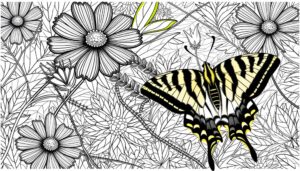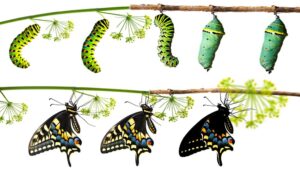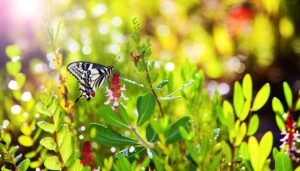Eastern Tiger Swallowtail Butterflies Nc: Observation Tips!
The Eastern Tiger Swallowtail (Papilio glaucus) is a striking butterfly prevalent in North Carolina, characterized by yellow and black striped wings.
Males are typically yellow, while females display sexual dimorphism with a dark morph option. They inhabit deciduous woodlands, river valleys, and suburban gardens, preferring high floral diversity.
Their life cycle includes complete metamorphosis, with larvae resembling bird droppings for camouflage. They play an important role in pollination, benefiting both native flora and crops.
Key observation sites include the Great Smoky Mountains and Blue Ridge Parkway. Discover more about their behaviors and ecological importance in the sections that follow.

Key Takeaways
Identification and Appearance
The Eastern Tiger Swallowtail (Papilio glaucus) is easily identified by its striking yellow and black striped wings, which span approximately 3.1 to 5.5 inches.
This lepidopteran belongs to the family Papilionidae, characterized by their large, vibrant wings and tails that resemble those of swallows.
Females display sexual dimorphism, with some exhibiting a dark morph where the yellow is replaced by a rich, velvety black, likely as a mimicry adaptation.
The dorsal forewings show four black tiger-like stripes, while the hindwings possess blue and orange spots near the tails.
The ventral side of the wings features a softer, paler coloration, enhancing its camouflage when at rest. This butterfly’s elegant appearance captures the essence of nature’s artistry, symbolizing freedom and transformation.
Life Cycle Stages
The Eastern Tiger Swallowtail (Papilio glaucus) undergoes a complete metamorphosis with distinct stages: egg, larva (caterpillar), pupa (chrysalis), and adult butterfly.
Females lay spherical, greenish eggs on host plants like wild cherry and tulip tree.
The caterpillars, initially resembling bird droppings for camouflage, eventually form a chrysalis where they undergo transformation into the vivid, winged adult stage.
Egg to Caterpillar
Observations of the Eastern Tiger Swallowtail (Papilio glaucus) reveal that females lay spherical, greenish eggs singly on host plants like wild cherry and tulip trees.
After approximately four to ten days, the eggs hatch, releasing first instar larvae. These young caterpillars exhibit a dark coloration and possess setae for protection.
As they progress through several instars, they develop distinctive eyespots and a greenish hue, mimicking bird droppings to deter predators. The larvae primarily consume the leaves of their host plants, demonstrating a voracious appetite.
This growth phase is critical, enabling the caterpillars to accumulate energy reserves essential for their subsequent transformation. By the fifth instar, they prepare to enter the pupal stage, marking the next phase of their metamorphosis.
Pupa to Butterfly
Upon reaching the pupal stage, Eastern Tiger Swallowtail larvae undergo a remarkable metamorphosis within their chrysalides, transforming from caterpillar to butterfly through a process known as metamorphosis.
During this phase, the larval tissues break down through histolysis, while imaginal discs form adult structures like wings and antennae.
The chrysalis (pupa) of Papilio glaucus, the scientific name for this species, typically exhibits mottled green or brown coloration, providing camouflage in their natural habitat.
Over a period of 10 to 20 days, depending on environmental conditions, the adult butterfly, or imago, emerges.
This final stage reveals the iconic yellow and black striped wings adorned with blue and orange spots. The emergence signifies the culmination of their complex life cycle.
Preferred Habitat
Eastern Tiger Swallowtail butterflies thrive in deciduous woodlands, river valleys, and suburban gardens, where host plants like wild cherry and tulip trees are abundant. Eastern tiger swallowtail butterflies are often seen gracefully fluttering among flowering plants, sipping nectar from blossoms such as lilacs, milkweed, and phlox. Their striking yellow and black wings make them easy to spot as they glide through sunny clearings and along forest edges. These butterflies play a vital role in pollination, helping maintain the health of their ecosystems.
These habitats provide essential resources for the species Papilio glaucus, including ample nectar sources and suitable oviposition sites.
Observations indicate a strong preference for areas with high floral diversity, enhancing their foraging efficiency. They often frequent open spaces near forest edges, maximizing sunlight exposure for thermoregulation.
Riparian zones offer moist conditions favorable for puddling behavior, a critical activity for nutrient absorption.
Suburban gardens with native flora can mimic natural habitats, supporting their lifecycle. These environments collectively sustain the butterflies’ ecological needs, promoting their presence across North Carolina.
Seasonal Behaviors
Throughout the year, Papilio glaucus exhibits distinct behavioral patterns that are closely tied to the seasonal changes in their environment.
During spring, adults emerge from pupae, engaging in mate-seeking flights and egg-laying on host plants like Liriodendron tulipifera and Prunus serotina.
In summer, larvae undergo rapid growth, displaying defensive postures and mimicry to deter predators. The adult butterflies are frequently observed engaging in mud-puddling behavior, which aids in nutrient uptake.
As fall approaches, the species enters diapause, with larvae forming chrysalides that will overwinter. These seasonal behaviors promote their survival and reproductive success, reflecting an intricate balance between life cycle stages and environmental cues.
Their adaptability underscores the resilience and fascinating life of Papilio glaucus.
Role in Pollination
The Eastern Tiger Swallowtail (Papilio glaucus) plays an essential role in pollination across North Carolina’s diverse ecosystems. By visiting native flora, they facilitate cross-pollination, which enhances fruit production and supports overall ecosystem diversity.
These butterflies, through their interactions with a variety of flowering plants, contribute greatly to the stability and health of local habitats.
Attracting Native Flora
In spring, Papilio glaucus actively seeks out native flora such as Asclepias tuberosa and Rudbeckia hirta, playing an essential role in their pollination. These butterflies, belonging to the family Papilionidae, exhibit a mutualistic relationship with these plants.
The Eastern Tiger Swallowtail‘s proboscis allows it to access nectar deep within the flowers, promoting cross-pollination.
This enhances genetic diversity among plant populations. Observations indicate that their vibrant coloration and flight patterns increase floral visitation rates.
The presence of these butterflies in North Carolina ecosystems highlights their significance in maintaining biodiversity.
By attracting such native flora, Papilio glaucus safeguards the sustainability and resilience of local plant communities, fostering ecological balance and supporting freedom in natural habitats.
Enhancing Fruit Production
Eastern Tiger Swallowtail butterflies (Papilio glaucus) greatly enhance fruit production by effectively pollinating a variety of angiosperms, including economically important crops such as Malus domestica and Prunus persica.
These lepidopterans exhibit synapomorphic traits that make them efficient pollinators. Their proboscis allows them to access nectar from deep floral structures, facilitating cross-pollination.
Observational data highlight that P. glaucus frequents orchards, transferring pollen grains between flowers during nectar foraging. This behavior increases genetic diversity and fruit set, essential for robust yields.
Supporting Ecosystem Diversity
Papilio glaucus plays a vital role in ecosystem diversity by aiding in the pollination of a wide array of flowering plants, thereby supporting various trophic levels and promoting biodiversity.
As a member of the Papilionidae family, this butterfly species visits numerous angiosperms, transferring pollen from one bloom to another.
Their proboscis allows them to access nectar, facilitating cross-pollination. Observations reveal that they frequent plants such as Liriodendron tulipifera (tulip tree), Asclepias spp. (milkweeds), and Buddleja davidii (butterfly bush).
This activity enhances genetic diversity within plant populations, contributing to robust ecosystems.
Through these interactions, Eastern Tiger Swallowtails indirectly support herbivores, carnivores, and decomposers, creating a balanced, thriving environment teeming with life.
Conservation Efforts
Efforts to conserve Eastern Tiger Swallowtail butterflies (Papilio glaucus) in North Carolina emphasize habitat preservation, pollution reduction, and public education.
Conservationists focus on protecting native host plants, such as tulip trees (Liriodendron tulipifera) and wild cherry (Prunus serotina), essential for larval development.
Reducing pesticide use is vital, as these chemicals can devastate both larvae and adult butterflies.
Public education campaigns aim to increase awareness about the butterfly’s ecological role and encourage community involvement in conservation activities, such as planting butterfly gardens and participating in citizen science projects.
Viewing Locations in NC
In North Carolina, prime locations for observing Eastern Tiger Swallowtail butterflies include the Great Smoky Mountains National Park, the Blue Ridge Parkway, and the Piedmont region’s diverse forests and meadows.
These habitats offer ideal conditions for Papilio glaucus, providing ample nectar sources and host plants. The Great Smoky Mountains National Park is renowned for its rich biodiversity, where one can spot these Lepidoptera in flower-filled meadows.
The Blue Ridge Parkway, with its scenic vistas, supports numerous butterfly species. In the Piedmont region, mixed hardwood forests and open meadows serve as ideal habitats.
| Location | Habitat Type | Notable Features |
|---|---|---|
| Great Smoky Mountains National Park | Rich biodiversity | Flower-filled meadows |
| Blue Ridge Parkway | Scenic vistas | Supports numerous butterfly species |
| Piedmont Region | Mixed hardwood forests, meadows | Diverse flora and fauna |
Observing these butterflies in their natural habitats allows for a deeper appreciation of their ecological roles.
Fun Facts and Trivia
Eastern Tiger Swallowtail butterflies (Papilio glaucus) exhibit fascinating sexual dimorphism, with females displaying both yellow and dark morphs, a rarity among butterfly species. This dimorphism aids in predator avoidance, enhancing survival rates.
The yellow morph mimics males, while the dark morph resembles the toxic Pipevine Swallowtail (Battus philenor), deterring predators through Batesian mimicry.
Papilio glaucus has a wingspan ranging from 3.1 to 5.5 inches, making it one of the largest butterflies in North Carolina. Found primarily in deciduous forests, they’re also frequent visitors to gardens and urban areas.
Their larvae exhibit an intriguing defense strategy, resembling bird droppings in their early stages and developing eyespots later to scare off potential threats. These butterflies symbolize transformation and freedom.
Conclusion
To sum up, the Eastern Tiger Swallowtail (Papilio glaucus) is a fascinating species with intricate life stages and essential ecological roles.
These butterflies, identifiable by their striking yellow and black wings, are important pollinators within their preferred habitats.
Importantly, they can be observed in numerous locations across North Carolina. An interesting statistic: a single Eastern Tiger Swallowtail can visit up to 30 flowers per minute, showcasing their efficiency.
Conservation efforts remain necessary to preserve their populations and habitats.






